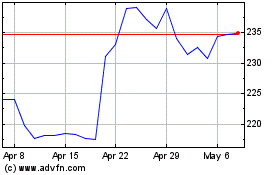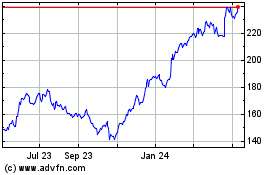Consumers Take a Credit-Card Breather
March 07 2017 - 5:06PM
Dow Jones News
By AnnaMaria Andriotis
The amount of credit-card debt held by U.S. consumers retreated
slightly in January.
Although consumer card balances in January were up 6% from a
year earlier, the amount of debt outstanding dropped slightly from
December, according to data released by the Federal Reserve on
Tuesday. That halted 10 months of consecutive increases.
Outstanding revolving debt, mostly comprising bank and store
credit cards, totaled $995.1 billion in January, down from $998.9
billion in December, the data showed.
Such a move down isn't unheard of at the beginning of the year.
In January, many consumers are in pay-down mode after racking up
holiday credit-card bills.
But it also could reflect an increase in charge-offs of
delinquent consumer debt. A three-month moving average of bank
credit-card debt through January showed write-offs increased 12%
from the three-month period through December, according to Equifax
data. The charge-offs were up about 24% from a year earlier.
This comes as missed payments are on the rise, although they
remain near historically low levels. Some 3.21% of bank credit-card
balances were in default in January, up from 2.52% a year earlier
and the highest since July 2013, according to the S&P/Experian
Consumer Credit Default Indices.
January's card-balance data mark a pause from what has been a
tear in credit-card-debt growth recently. Growth in such debt has
been accelerating, rising about 6.5% between December 2015 and
December 2016 compared with a roughly 5% increase the year earlier
and a 4% increase two years before. In 2012, it increased by just
1.4%.
The credit-card market has become one of the most upbeat
consumer lending markets in the last couple of years. Purchases on
the four largest payment networks -- Visa, Mastercard, American
Express and Discover Financial Services -- increased 8% in 2016 to
$3.1 trillion, according to a report this week by ratings firm
DBRS.
Lenders have been going head-to-head to get more card users by
rolling out more generous rewards programs. Cards are an attractive
business because of the double-digit rates that lenders often
charge.
Lenders issued nearly 61 million general-purpose credit cards
from January through November of 2016, up 11.4% from a year prior
and a nine-year high, according to data from Equifax. Total credit
limits on these cards were $313.7 billion, up 18% from the previous
year -- and at the highest level since Equifax began tracking
full-year data in 2006.
Many lenders, including J.P. Morgan Chase & Co. and
Citigroup Inc., have also been offering credit-line increases to
existing customers.
Write to AnnaMaria Andriotis at annamaria.andriotis@wsj.com
(END) Dow Jones Newswires
March 07, 2017 16:51 ET (21:51 GMT)
Copyright (c) 2017 Dow Jones & Company, Inc.
American Express (NYSE:AXP)
Historical Stock Chart
From Mar 2024 to Apr 2024

American Express (NYSE:AXP)
Historical Stock Chart
From Apr 2023 to Apr 2024
